Author: Admin
-

Plant Growth Regulators: Definition, Types, and Mechanism
Continue ReadingWhat are Plant Growth Regulators?
The plant growth which is irreversible, progressive and unlimited is mainly because of the fact that specialized meristem regions are capable of having an indefinite cell division when required and are regulated by internal factors.
Genetic makeup and other physiological factors namely hormones are responsible for the condition of unlimited growth of the plant.
Unique set of hormones are well developed which regulates the development of the plant in a way where it balances the growth of the plant and it retains it by a gradual process.
Plant Growth Regulators (PGR) are hormones which acts on cells to promote and inhibit when stimulated.
Plant Growth Regulators and hormones are similar terms, hormones generally cover a broad portion of compounds and Plant Growth Regulators’s are plant hormones or phytohormones which are specialized in cell division, elongation, growth of a plant body.
Hormones are simple molecules having varied diverse composition.
They are required in minimal amount for the growth of organism
Plant Growth Regulators History
The discovery was accidental and had many experimentations while concluding its actions.
Charles Darwin and Francis Darwin observed the plant response to light and uneven growth towards light was observed. Between 1950 – 1960 a group of hormones were discovered and were named as “classical five” – Auxin, Gibberellin, Abscisic Acid, Ethylene and Cytokinin.
Following this many natural and synthetic regulators were discovered later.
Characteristics of Plant Growth Regulators
• Hormones are pleiotropic in nature
Example: Auxin helps in cell division, elongation, apical dominance etc.
• Several hormones act for same responses leads to reduced response for a particular stimuli / action
• Small concentration is required
• Hormones are synthesized at different parts of the plant body and are transported to the site of action
• Hormone action is time specific and precise
• Hormones can be stimulator or inhibitor
Types of Plant Growth Regulators
Plant hormones are of 2 types:
1. Growth promoters: promote cell division, cell elongation, pattern formation, seed and fruit development
2. Responser: Biotic and Abiotic cues response and for stressors
Plant Growth Regulators and Their Functions
I. Auxin
• Naturally occurs as Indole 3 Acetic Acid.
• Synthesis: Leaf primordia and young leaves
• Transportation: flows through phloem
• Induces overall polarity of root shoot polarity
• Basipetal transportation of hormones from tips of leaf to the leaf and stem and similarly, root tips → root – shoot differentiation zone.
• Apical dominance reduces the Abscission in apical region
• Auxin are signal mediated multiple level coordinated developmental processes
II. Cytokinin
• Promote cell division
• Transported to shoot from root through Xylem
• Activates lateral bud formation
• Pro – vascular tissue formation
• Positive geotropism is observed
• Inhibitors of root development and control meristem activity
III. Ethylene
• Simple hydrocarbon which is volatile
• Present in Seeds of all plants
• Transportation by: Diffusion
• Production sites: shoot apices, nodal region of stem
• Ripening process in climacteric fruits
• High production during stress
• Ethylene promotes leaf abscission
IV. Abscisic Acid
• Present throughout the plan body
• Aids in Abscission triggered by ethylene
• Transportation: Xylem and Phloem. Abundant in Phloem
• When water is in excess, ABA transports to stomata through xylem which induces stomatal closure
• High production during seed protein synthesis and seed development
• Break dormancy in seeds
V. Gibberellins
• Tetracyclic diterpenoids
• In seed and fruit development
• Growth of bud, Leaves, Internodes
• Transportation via Phloem
• Stem and leaf elongation also in root elongation and pollen tube growth
• Secretes enzymes
Plant Growth Regulators Citations
- Oligosaccharins as plant growth regulators. Biochem Soc Symp . 1994;60:5-14.
- On plant growth regulators and their metabolites: a changing perspective. Semin Cell Biol . 1993 Apr;4(2):87-92.
- Synthesis and preliminary evaluation of dimeric-28-homobrassinosteroids for plant growth regulators. Steroids . 2016 Dec;116:38-44.
- An integrated network of Arabidopsis growth regulators and its use for gene prioritization. Sci Rep . 2015 Dec 1;5:17617.
- A high efficient adsorbent for plant growth regulators based on ionic liquid and β-cyclodextrin functionalized magnetic graphene oxide. Talanta . 2019 Mar 1;194:14-25.
Share
Similar Post:
-

Cell Differentiation: Definition, Process, and Stages
Continue ReadingWhat is Cell Differentiation and Development?
Plant develops from a single celled zygote to multicellular, tissue level coordinated living being by the process of development and growth.
The development, growth, distinction between different parts of a organisms is determined by the genetic material by a gradual process of cell division.
Cell division is the primary process where continuous division leads to a pattern formation. The pattern formed is based on the symmetry of the division and the cytoplasmic distribution during cell division.
When a zygote becomes an 8 – celled blastomere the cytoplasmic contents of one cell are evenly or unevenly distributed in all cells.
Further, positioning of an embryo and environmental cues differentiates the cell further making each part of the cell a distinct and specified region.
This overall mechanism is a gradual process involving commitment, determination and differentiation.

The 3 processes are overlapping with negligible differences. Commitment is the determination of cell fate of a particular cell. Determination is similar to commitment where a part of the embryo gets determined to develop into a particular organ.
Differentiation is the process where the determined part divides and transforms to a specialized region with definite structure and function.
The differentiated parts get matured after the process. The main difference between plants and animal differentiation is unlimited growth in plants which demands an extra process called dedifferentiation and redifferentiation.
Elongation of leaves will initiate matured cell to dedifferentiate to gain its embryological function of continuous proliferation to attain desirable growth after which the cells attain its specific role which is redifferentiation.
Cell Division and Cell Differentiation
Cell division is crucial in differentiation of group of cells according to its functional and structural specificity.
The unequal distribution of proteins and other essential nutrients at each cell division to daughter cell determines the determination of each part and its differentiation.
The distribution may be supported by the cytoskeleton which transports and orients the nutrients appropriately.
Many scientists claim the asymmetrical cleavage leads to the formation of different parts. Formation of sieve cells, companion cells trichoblast are result of asymmetrical division of zygote.
Few scientists believe that nearly symmetrical daughter cells have different composition of cytoplasm.
The synthesis of protein and gene expression varies the mother cells composition from daughter cells.
In both the division the accumulation of varying composition of cytoplasm is essential in cell differentiation.
During such division the daughter cells does not inherit all the ability of mother cell. Each division restricts the differential ability of the cell making it more specific in nature.
Mechanism of Differentiation
Differentiation is by limiting gene transcription and expression of a cell which defines a cell’s function.
Other functions apart from prescribed function are eliminated or not expressed. Each differentiated region has separate function and specialized materials present in them.
For example: Mesophyll cells in leaf has 40 – 50 chlorophyll, 106 photoreceptors, chlorophyll a and b, enzyme essential for photosynthesis namely RUBISCO – Ribulose 1,5 – bisphosphate carboxylase/oxygenase.
Similarly in root cell, lacks chlorophyl, photoreceptors proteins of chlorophyll instead they carry starch storing plastids namely amyloplast. Both leaf and root contain same genomic DNA but expression of gene and other activities determines the part which the cell must occupy.
The mechanisms are monitored by 3 types of gene namely:
1. Housekeeping genes
2. Cell or tissue specific genes
3. Regulatory genes
Housekeeping genes are common genes which are widely present at any part of the body doing respiratory, storage sugar uptake, protein synthesis etc.,
Cell or tissue specific genes are present in all types of cells or tissue but gene expression is limited to a cell type or tissue.
For example:
a. Chlorophyll proteins, photoreceptors, RUBISCO enzyme are present only in the mesenchymal cells.
b. Amyloplast are present only in roots for storage purpose in parenchymal cells
c. PHENYLALANINEAMMONIA LYSE gene is present in seed. The enzyme encoding gene helps in lignin synthesis in xylem.
Regulatory genes, synthesis proteins involved in signaling. These are encoded by multigene complexes known as Homeobox genes which are specified in determining the pattern for future differentiation.
For example: Plant Homeobox genes determine the patterning of the future structure, determination of cell fate, defining boundaries between different tissues and organs.
KNOX I genes are specified for patterning shoot meristem and differentiates them from lateral organs by not expressing them in lateral part of the plant.
As a whole differential gene expression and inhibition combinedly forms differentiated parts of the tissue or plants.
Changes During Cell Differentiation
a. Endopolyploidy is observed in Angiosperm – chromosomes differentiate number of times without cell division is known as endopolyploidy.
b. Cell size increases unequally
c. Tissue expresses coordinate growth with intrusive cell growth where new cells are included in between the existing cells. The intrusive cell grows coordinated with existing cells. For example: root hair cell developing from root primordium.
Dedifferentiation
A matured cell changes its metabolic activity and modifies its gene function and attains its zygotic cell division abilities to divide and differentiate to new cells.
Changes During Dedifferentiation
a. Loss of stored food
b. Thinning cell wall
c. In cell culture, polar or amoeboid growth observed
d. Ploidy level changes
Changes During Re-differentiation
Once matured cells after dedifferentiation attains new additional functions than their previous matured state.
Cell Differentiation Citations
- Acidic cell elongation drives cell differentiation in the Arabidopsis root. EMBO J . 2018 Aug 15;37(16):e99134.
- Trichomes as models for studying plant cell differentiation. Cell Mol Life Sci . 2013 Jun;70(11):1937-48.
- Control of plant cell differentiation by histone modification and DNA methylation. Curr Opin Plant Biol . 2015 Dec;28:60-7.
- Emerging concepts in chromatin-level regulation of plant cell differentiation: timing, counting, sensing and maintaining. Curr Opin Plant Biol . 2016 Dec;34:27-34.
- In situ cell differentiation monitoring of Catharanthus roseus suspension culture processes by NIR spectroscopy. Bioprocess Biosyst Eng . 2020 Apr;43(4):747-752.
Share
Similar Post:
-

Plant Development: Definition and Stages I Research...
Continue ReadingWhat is Plant Development?
Growth and development of any organism is closely associated with cell division and nutrient uptake by the organism.
The open form of growth produced by the meristem makes a plant have an unlimited growth and makes it unique mechanism for survival.
The life history of an organism is depicted as the development of organism from its birth to death.
The cumulative changes in the living system, physiological and metabolic activities, different phases of grow and reproduction are all an important aspect of development of an organism.
The development initiates from the zygote and covers the entire life processes including structural maturity and functional maturity.
The development is always about the pattern formation and combination of functions and is important as it ensures the survival of progeny and takes place in evolution of whole living organism.
Plant Development Process
The changes and modification taking place during the zygote differentiation corresponds with the developmental cues for the plant maturation and growth in the future.
The basic plan for survival is well laid in the zygote as basic differentiation becomes well defined and acts as a key for body plan of the whole organism.
The development is gradual and progressive takes place in a sequence, they are:
Plant Development Steps
1. The zygote, a highly organized precursor develops into embryo by embryogenesis
2. The 2 basic body patterns are formed by the asymmetrical division: apical -basal pattern and radial pattern.
3. Polarity of the cell is established and apical and basal part is determined
4. After subsequent cell division and differentiation, the meristematic tissue is formed
5. The primary meristematic tissues are protoderm, ground meristem and procambium
6. Cell divisions takes place now at the apical portion of the polar sides – bipolar differentiation distinguishing root and shoot.
7. The primary meristematic tissues formed are especially for the elongation.
8. These primary meristematic tissues now mature to form cotyledons forming a radicle and plumule – root and shoot primordia.
9. Cotyledons stages are seed germination period where the shoot differentiates into leaves, nodes and internodes.
10. The formation and development of root and shoot is the vegetative growth of the plant
11. On further differentiation when the apical meristem give rise to floral apical meristem this is the reproductive stage.
12. The primary successive growth results due to the apical meristem.
13. The primary tissues increase in thickness (i.e.) girth and enter secondary growth.
14. Secondary growth results in the radial thickening of the plant results in increase of cell division in secondary cambial growth.
15. The secondary growth meristem results in the production of vascular cambium – secondary vascular cambium tissues.
16. The lateral meristem aids in increase of volume of the secondary tissues.
17. The maturity of plant leads to the termination of plant’s life after the maturation and differentiation.
18. Senescence is the gradual programmed cell death which can be controlled by the chemical regulators of the plant
19. Senescence can also be caused by the accumulation of change which decreases the productivity if an organism causing death.
20. The development, differentiation and maturation is a gradual process, similarly the senescence is also a gradual process where the plant reduces the utilization of basic proteins for the synthesis of food and energy. Later reduced metabolism will lead to death of the plant under natural condition.
Plant Development Citations
- Plant Development: How Leaves Take Shape. Curr Biol . 2019 Aug 19;29(16):R803-R805.
- Phyllotaxis as geometric canalization during plant development. Development . 2020 Oct 12;147(19):dev165878.
- Shape and form in plant development. Semin Cell Dev Biol . 2018 Jul;79:1-2.
- Expanding roles for pectins in plant development. J Integr Plant Biol . 2018 Oct;60(10):910-923.
- Functions and Regulation of Programmed Cell Death in Plant Development. Annu Rev Cell Dev Biol . 2016 Oct 6;32:441-468.
- Cadmium and Plant Development: An Agony from Seed to Seed. Int J Mol Sci . 2019 Aug 15;20(16):3971.
Share
Similar Post:
-

Aneuploidy: Definition, Types, Causes, and Examples
Continue ReadingWhat is Aneuploidy?
Generally, ploidy refers to the number, and here ploidy is the number of chromosomes present in the diploid set of homologous chromosomes that make up a genome of an organism.
Aneuploidy is one such type of ploidy, where the abnormal number of chromosomes are present in the individual where 45 or 47 chromosomes are present instead of 46.
Everything which are used up in pairs can be used only if their sets are available, considering from shoes, shocks, earrings, lenses, ear pods etc. Thus pairs are very important in the genetics where chromosomes play a key role in functioning of an organism in an appropriate manner.
Where the pair of chromosomes should be 2n, lesser or higher from this number causes many disorders and abnormality in an individual.
Aneuploidy is the condition where the person have a missing or an extra chromosome. Usually, any change in the number or structure of a chromosome is known as mutation and it is considered as one of the chromosomal disorders.
Chromosomal disorders are classified into two types based on the structural abnormality and numerical abnormality.
This numerical abnormality is further sub divided into euploidy and aneuploidy where euploidy is the condition where there is the presence of complete set of chromosomes (2n).
The other sub type is Aneuploidy where there is an addition or deletion in a 2n set of chromosomes.
Features of Aneuploidy
Aneuploidy is defined as the addition of an extra chromosome or removal or absence of a chromosome from any of its pair.
Each species contains a definite set of chromosomes where human contain 46 chromosomes which are 23 in pair to form a typical body cell and proper functioning of the parts.
If a cell contains one or two chromosomes extra or lesser than the normal pair then it is said to be aneuploidy.
This results in many disorders or abnormalities in a person, where in aneuploidy “an” refers to improper; and “ploidy” refers to number, and hence improper number of chromosomes causes this disorder.
Types of Aneuploidy
Aneuploidy is classified generally as hypoploidy and hyperploidy;
1. Hypoploidy
Hyploidy is generally defined as loss or lesser number of chromosomes compared with the normal 2n chromosomes.
The hyploidy is further sub divided as monosomy and nullisomy
Monosomy: Loss of one chromosome in a pair(2n-1)
Nullisomy: Loss of one pair (2n-2). The children having this condition has only lesser chance of leading a life.
2. Hyperploidy
This results in addition of one or more chromosomes. It is subdivided into types as
Trisomy: This condition results in extra chromosome on cells. It often results in Klinefelter’s syndrome with a trisomy in chromosome 21.
Tetrasomy: This condition results in addition of a pair of chromosomes.
Diploid: This condition results in addition of one chromosome in an monoploid organisms.
There are three most common types of aneuploidy that is occurring often; there are;

Monosomy
Here the organism contains one chromosome lesser (2n-1) in number than the normal, where humans contain 45 chromosomes instead of 46.
One of the examples for monosomy is TURNER’S SYDROME, where girls are mostly affected with this condition due to loss of one chromosome in the allosome set.
It leads to various developmental abnormalities and many severe symptoms.
The people with this condition are sterile in nature and short in stature and webbing of neck region is seen.
Trisomy
The individual contains addition of a n extra number of chromosomes. Which is 2n+1 in any one pair of the chromosome. Where they contain 47 chromosomes instead of 46.
One of the examples of trisomy is DOWN SYNDROME, which is due to the presence of an extra number in chromosome 21 which leads to many abnormalities.
It occurs mostly in 1 of 800 births. This factor mostly occurs if the child’s mothers age is above 35. This occurs due to the abnormal cell division during mitotic and meiotic phases.
The symptoms of this disorder include short stature, mental retardation, small head, poor muscle tone.
Causes of Aneuploidy
The chromosomal disorders mostly occur due to an occurrence of non-disjunction of chromosomes.
They occur when the two homologous sister chromosomes failed to separate during the stages of meiosis.
Meiosis I: In meiosis I the failure of non-disjunction of homologous chromosomes occurs during cell division.
Meiosis II: In Meiosis two, the failure of separation of sister chromatids occurs.
Mitosis: Non-disjunction of chromosomes also occurs in mitosis phases. In humans, the non-disjunction of chromosomes during mitosis does not pass through the next generation.
But in mitotic, non-disjunction causes other abnormalities. Cancer also occurs mostly due to the non-disjunction of chromosomes in the mitotic cells.
Considering an aneuploid condition, where the normal sperm combines with an aneuploid condition egg then it form an abnormal zygote as 2n+1 or 2n-1.
Where as in normal conditions normal sperm and a normal egg combines to form a normal zygote which is 2n.
Aneuploidy Citations
- A Double-Edged Sword: Aneuploidy is a Prevalent Strategy in Fungal Adaptation. Genes (Basel) . 2019 Oct 10;10(10):787.
- The impact of aneuploidy on cellular homeostasis. Free Radic Res . 2019 Jul;53(7):705-713.
- Oocyte development, meiosis and aneuploidy. Semin Cell Dev Biol . 2015 Sep;45:68-76.
- Aneuploidy Screening in Pregnancy. Obstet Gynecol . 2016 Jul;128(1):181-194.
Share
Similar Post:
-

Polyploidy: Definition, Types, Causes, and Examples
Continue ReadingWhat is Polyploidy?
As we all know chromosomes make up the important part of our cells by giving instructions for the production of certain enzymes and also in carrying the hereditary characters for future generation.
Any change or mutation in the structure or number of a chromosome results in chromosomal disorders.
Where any change in number of chromosomes is referred to as ploidy.
If there is addition of one or more numbers in a chromosome it is referred to as polyploidy.
Characteristics of Polyploidy
Polyploidy is a condition where the diploid cell consists of more than a 2n number of chromosomes than normal.
It results in many disorders and abnormalities in functioning of a cell. Where the cell with this polyploid condition has three or more extra chromosomes.
This condition often occurs in plants and other lower vertebrates like fishes and in amphibians. In plants it also especially occurs in angiosperms.
The most important type is allopolyploid which results in doubling or duplication of all chromosomes in a hybrid plant.
The polyploidy in plant is very beneficial as it induces the vigorous fertility in plants and gives good yield especially in angiosperms. so the farmers often feed the plant with some chemical polypoid triggers like colchicine.
Polyploid in animals is also not very common because it causes affects in most of the species.
Cause of Polyploidy
One of the major causes of ploidy is due to the non-disjunction of sister chromatids. This occurs mostly during the meiotic cell divisions.
Before undergoing meiosis, the chromosome number is doubled during gamete formation. These mutations in apical meristems results in doubling of growth in plants.
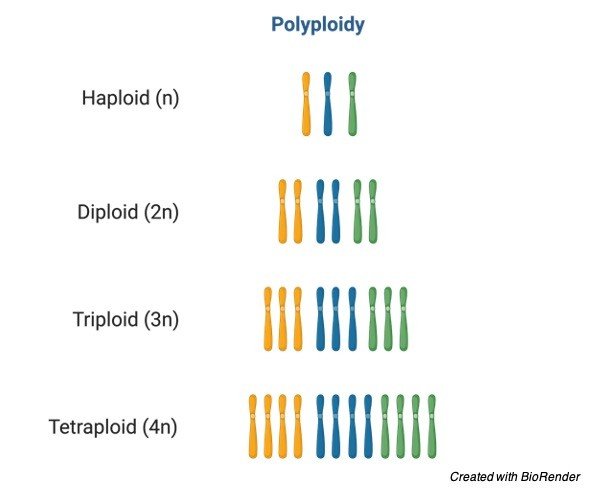
Allopolyploidy, which is a type of polyploidy results as a hybridization between two genome sets.
The combination of initial sterile hybrids with the other set of chromosomes results in sterile and genetically unstable condition of the plants; This on undergoing meiosis further doubles the chromosomes and creates a stable plant.
However, artificial polyploidy has been used in researches now a days for good commercial and economic purposes. Mostly the farmer uses the colchicine, the chemical inducer for the crops which interferes with the meiotic spindle formation.
Even the crosses are made between polyploids to increase the value of the vegetative parts of the plant. Usually banana, Bermuda is crossed between diploid and tetraploid species by the cultivars to increase the yield.
Types of Polyploidy
Generally, there are two types of ploidy they are autopolyploidy and allopolyploidy which is also known as amphipolyploidy. These are also subdivided into many categories.
1. Autopolyploidy
This condition results when there are multiple set of chromosomes and these chromosomes which form a multiple set are derived from a single genotype, which results in somatic doubling of cells and end up in formation of zygotes at the apical meristems.
Here the doubling occurs evenly and the existing chromosomes are doubled up, which results in multivalent pairing at the stage of meiosis.
There are two types of allopolyploidy as
a. Strict Autopolyploidy: This condition results in the doubling of chromosome evenly and it also occurs within the same individual.
b. Interracial Autopolyploidy: This condition occurs as a result of cross between different individual but these individuals have similar genotype.
2. Allopolyploidy
This condition occurs as a result of meiotic recombination’s between different genomes, so that the resultant obtained will be either odd or even in number.
This condition often results in bivalents of the species which increases the rate of fertility in offspring. Mostly allopolyploidy causes only reduced vigour in plants.
The economically important plants like strawberry, wheat, cotton, mustard, blueberry is grown with the help of allopolyploid inducing fertilizers which gives better yield.
Importance of Polyploidy
Polyploidy is one of the important and major cause the evolution the species. It is very important for the plants in increasing their vigour and size.
This phenomenon is similar to that of heterosis which helps in improving the economically important crops and flowering plants.
Polyploidy in Humans and Animals
As said earlier polyploid is a condition where an organism have a greater number of chromosomes than normal.
Most species of eukaryotes have their cell nuclei as a diploid condition which means that they have two set of chromosomes.
Each of them inherit their genes from each of the parents. As polyploid is most common in plants, it also occurs in humans and animals at some cases.
Polyploid generally occurs due to an abnormal cell division during the phases of mitosis or meiosis.
Polyploidy commonly occurs in highly differentiated tissues of our body such as in liver, heart muscles and in bone marrow and in the placenta regions. In animals such as lower vertebrates like fishes such as gold and salmon fish and also in amphibians such as salamanders.
It is rare occurring in human because it leads to death of the organism by duplicating the number of chromosomes.
Whereas in plants it results in diploid, triploid, tetraploid and hexaploidy which is often followed in food crops
Polyploidy vs Aneuploidy
Aneuploidy is a condition where the individual is having an extra number of chromosomes or loss or deletion one chromosome which leads to monosomy or deletion or addition of a chromosome to a normal pair results in trisomy.
These conditions give rise to various disorders such as Downs syndrome, Klinefelter’s syndrome and turners syndrome.
Where as Polyploidy is a condition where there will be addition of two or more set of the chromosomes and this condition mostly occurs only in plants and it is also beneficial among them by providing excess yield than normal and this condition is mostly possible with hybrid plants.
Polyploidy Citations
- Polyploidy in liver development, homeostasis and disease. Nat Rev Gastroenterol Hepatol . 2020 Jul;17(7):391-405.
- Polyploidy and interspecific hybridization: partners for adaptation, speciation and evolution in plants.
- Polyploidy: A Biological Force From Cells to Ecosystems. Trends Cell Biol . 2020 Sep;30(9):688-694.
- The evolutionary significance of polyploidy. Nat Rev Genet . 2017 Jul;18(7):411-424.
- The polyploidy and its key role in plant breeding. Planta . 2016 Feb;243(2):281-96.
Share
Similar Post:
-

Down Syndrome: Definition, Causes, Symptoms, and Diagnosis
Continue ReadingWhat is Down Syndrome?
We know that abnormality in a structure or function of a chromosome leads to various chromosomal abnormalities or disorders. These disorders sometimes make a human an unfit to live a comfortable life with a good healthy lifestyle.
However, these disorders sometimes lead to mortality of an individual even at birth or it also results in lower lifespan of a person.
Down syndrome is also a one such genetic disorder which results in various physical and mental retardation.
This condition is as a result of addition of an extra chromosome in the chromosome number 21 which is also known as trisomy of the chromosome 21.
This is considered as one of the leading genetic disorder in the world.
This condition was first observed by the physician named Langdon Down.
The important physical condition that affects the individual due to this disorder is mental retardation.
The individuals affected to this disease are mostly suspectable to other diseases such as leukaemia and Alzheimer’s disease.
This condition has no treatment or medication and it’s a life long syndrome. But people with this syndrome are practised in speech and language therapies to improve their intellectual activities.
Down syndrome can be diagnosed at the time of pregnancy itself, many such population can be reduced by the decision of the parents.
Causes of Down Syndrome
Down syndrome is due to the addition of one extra chromosome to an 21st chromosome, which is resulted due to the aneuploidy of the chromosome.
This extra chromosome is present in all cells of the body in the chromosome number 21.
This condition occurs 1 in 800 lives. The important risk factor to be consider here is the age of the mother, because the mothers who are above the age of 35 can pass this condition to their children.
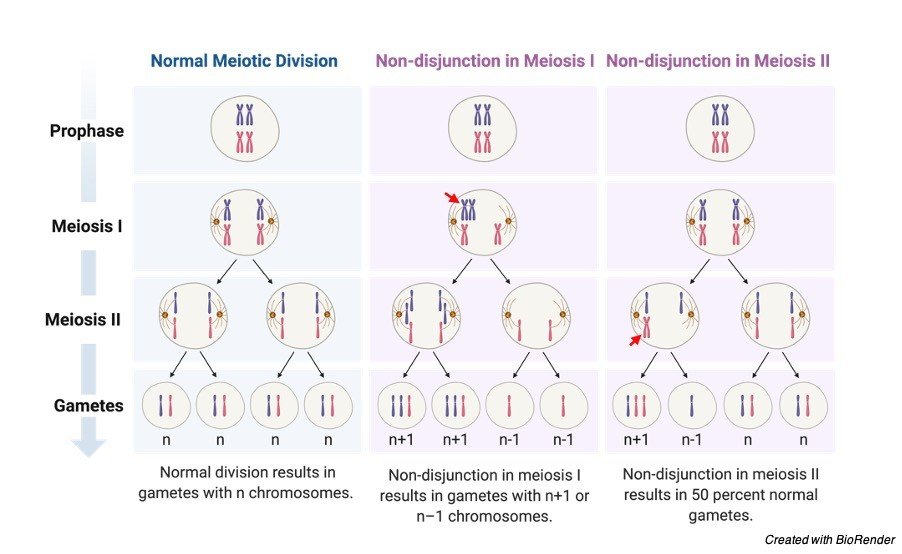
Downs syndrome is due to abnormal cell division in the mitotic and meiotic phases, where the chromosome pair are separated and each chromosome are allowed a get another copy of the chromosome. Which results in giving rise to unequal set of chromosomes. This process is generally known as non-disjunction of chromosomes.
Non-disjunction of chromosomes results when the chromosomes are segregated before all of the segregated chromosomes.
The daughter cells contain less chromosome with one extra chromosome, where the kinetochores are attached to the microtubules during metaphase at the opposite poles.
Down syndrome also occurs if translation occurs between two parts of the chromosome. In this case the number of chromosomes is normal but they have an additional part along with them.
But there will be no change or missing of any information but there will be extra segment which results in mental retardation. Of the all-inherited syndromes, Down syndrome does not occur mostly through inheritance. Where as the translocated downs syndrome can be passed from parents to offspring and it is inherited, but here the inherited parent will not show any symptoms for this condition, as the gene is found hidden in them and they are considered as carrier of this disease.
The individuals having this syndrome has a life span of about 60 years approximately.
Types of Down Syndrome
Down syndrome is generally classifying as three types as Trisomy of chromosome 21, Mosaicism, translocation.
I. Trisomy of Chromosome 21
Trisomy of chromosome 21 is the most happening and common type of downs syndrome. Here the extra number of chromosomes is present in the chromosome number 21 which leads to 47 number instead of 46 number of chromosomes.
The main reason for this condition is due to the non-disjunction of chromosomes during meiosis at the time of gamete formation.
Mosaicism
This condition occurs when non-disjunction of chromosomes occur in the mitotic division during the formation of zygote, at the time of fertilization.
This is the rarest type of syndrome occurring in humans. It is considered as mosaicism because some cells have normal 46 number of chromosomes where as the other cells contain extra chromosome which means 47 chromosomes.
Symptoms are not much severe in mosaicism. This condition is very rare among individuals.
Translocation
This condition occurs when the translocation occurs in the long arm of the chromosome. Where the q arm of the chromosome 21 gets translocated to the other chromosome. Where this portion of chromosome get located often to the chromosome 14.
This condition is not due to the mothers age or any other factors it is because of the inherited conditions.
Symptoms of Down Syndrome
People who are suffering with downs syndrome has many abnormalities in both physical and mental condition.
They have very poor immunity, so that they get easily affected with many diseases, such as sleep apnea, gastrointestinal defects, heart defects, thyroid infections.
They are also easily affected with Alzheimer’s and leukaemia.
The people with these conditions can be identified easily through their physical appearance and their activities. After every stage of life, they come across different symptoms.
The infants with this syndrome start growing slowly and they remain short as compared to others of same age.
The main symptoms of this syndrome are stunted growth with short stature, and fold of a flap of skin above the eyes with slanted eyes, protrusion of tongue and flattened nose, mental retardation, cardiac deformities, poor muscle tone but they have good flexibility, and as they have poor language development, they need language therapy and cognitive impairment.
Diagnosis of Down Syndrome
Children with this syndrome are often diagnosed after birth. But due to their different physical structures they are easily identifiable.
If these disorders are identified after birth they cannot be treated or cured. But the activities of the individual can be corrected through undergoing therapies.
It can also be diagnosed before giving birth by amniocentesis, where the amniotic fluid is taken from the mother’s womb with the help of the needle and they are tested by karyotyping as the genetic content of the amniotic fluid the foetus is same.
If the foetus is found to be abnormal, then it is aborted with the parents decision. However, this condition is becoming more common in every region in the world.
Down Syndrome Citations
- Integrated care for Down syndrome. Congenit Anom (Kyoto) . 2016 May;56(3):104-6.
- Down syndrome. Pediatr Clin North Am . 1993 Jun;40(3):523-35.
- Down syndrome, increased risk of dementia and lipid disturbances. Dev Period Med . 2017;21(1):69-73.
- Role of the family physician in the care of children with Down syndrome. Am Fam Physician . 2014 Dec 15;90(12):851-8.
- Down syndrome–genetic and nutritional aspects of accompanying disorders. Rocz Panstw Zakl Hig . 2015;66(3):189-94.
- Down Syndrome. N Engl J Med . 2020 Jun 11;382(24):2344-2352.
- Down syndrome: a review of the literature. Oral Surg Oral Med Oral Pathol Oral Radiol Endod . 1997 Sep;84(3):279-85.
- Endocrine manifestations of Down syndrome. Curr Opin Endocrinol Diabetes Obes . 2018 Feb;25(1):61-66.
Share
Similar Post:
-

Mitochondrial Disease: Causes, Symptoms, and Diagnosis
Continue ReadingWhat are Mitochondrial Diseases?
Mitochondrial Diseases are varied and are specific organelles in each cell of the body (except red platelets which do not have mitochondria).
Mitochondria produce over 90% of the energy needed by the body. Mitochondrial brokenness exhausts cells of energy causing cell harm and even cell passing.
Because of the great energy necessities of the body, the mitochondrial disease regularly influences these pieces of the body causing Brain and Muscle disease.
Different organs are much of the time influenced including eye, ears, heart, liver, gastrointestinal plot, liver, kidney, endocrine framework, and blood.
Symptoms of Mitochondrial Disease
A few indications of mitochondrial diseases are inconspicuous while others are long lasting and effectively noticeable.
Mitochondrial disease can either be seen in a grown-up or kid; typically, adolescence mitochondrial disease is more astringent and incorporates neurological, cardiovascular, and liver disorders.
A broad cluster of manifestations might be evident in youth mitochondrial disease, counting laziness, hypotonia, inability to grow, seizures, cardiomyopathy, deafness, visual deficiency, development issue, and lactic acidosis.
On the other hand, most patients with mitochondrial disease don’t show entirely perceptible indications.
Most conspicuous side effects can generally be credited to different causes; nonetheless, further examination may prompt mitochondrial changes being the authoritative reason, particularly these indications inside the accompanying frameworks.
Mitochondrial diseases of the focal sensory system or the fringe sensory system normally show the cliché youth indications, for example, formative deferral or relapse, seizures, and development issues.
In grown-up beginning mitochondrial disease, manifestations would rather include stroke or stroke-like scenes.
Indicative or non-symptomatic fringe neuropathy might be uncovered upon physical assessment or through nerve conduction examines.
Due to mitochondrial illnesses inside the hear-able framework, sensorineural deafness because of cochlear brokenness and brokenness of mitochondria inside cranial nerve VIII may happen.
Since ocular muscles contain the most elevated thickness of mitochondria per cell of a muscle and subsequently utilize a lot of adenosine triphosphate, mitochondrial disease inside the ocular framework are fairly bountiful.
Mitochondrial Disease Diagnosis
Actual assessment and research center tests are important to portray association of different organs and to arrive at the right determination.
Lab concentrates commonly include: blood tests, MRI or CT exam, heart tests, ophthalmological and neurological assessments.
At long last, hereditary testing of blood, pee, or muscle is performed to pinpoint the specific change answerable for a particular disease.
Treatment of mitochondrial diseases is restricted. Treatments to treat explicit manifestations and indications of mitochondrial diseases are vital.
For instance, in mitochondrial patients, epilepsy commonly reacts to anti-convulsant drugs while insulin and other standard medicines are successful for diabetes mellitus.
Retinitis pigmentosa is an acquired mitochondrial condition that includes the two eyes. In the event that it begins in one eye, it generally moves to the following eye.
There are around 75,000 individuals in the United States with retinitis pigmentosa (RP). Since retinitis pigmentosa starts as pole degeneration, the patient first notification is expanding trouble in night vision, trailed by trouble finding in the fringe.
Gradual constriction causes disruption in the visual field leading to tunnel sight.
A little space of focal vision in the two eyes generally endures for quite a long time. By and large night visual impairment goes before limited focus by years or even many years.
All out visual deficiency, in the long run, follows much of the time. For quite a long time, Vit. A treatment has been suggested for some RP patients, in view of examination tracing all the way back to the mid 1990s. , it has been the solitary treatment found that eases back the RP cycle.
Causes of Mitochondrial Disease
Mitochondrial issues might be brought about by transformations (gained or acquired), in mitochondrial DNA (mtDNA), or genes in the nucleus that code for mitochondrial segments.
They may likewise be the consequence of procured mitochondrial brokenness because of unfavourable impacts of medications, contaminations, or other ecological causes.
Oxalate may enter cells where it is known to cause mitochondrial brokenness.
Illustration of a family for a hereditary characteristic acquired by mitochondrial DNA in creatures and people.
The posterity of the male with the characteristic doesn’t acquires the attribute.
The posterity of the females with the characteristic consistently acquires the attribute (freely from their own sexual orientation).
Nuclear DNA has two duplicates for each cell (with the exception of sperm and egg cells), one duplicate is acquired from the dad and the other from the mother.
Mitochondrial DNA, notwithstanding, is acquired from the mother just (for certain special cases) and every mitochondrion normally contains somewhere in the range of 2 and 10 mtDNA duplicates.
During cell division the mitochondria isolate arbitrarily between the two new cells.
Those mitochondria make more duplicates, typically arriving at 500 mitochondria per cell. As mtDNA is replicated when mitochondria multiply, they can collect irregular changes, a marvel called heteroplasmy.
If by some stroke of good luck, a couple of the mtDNA duplicates acquired from the mother are deficient, the mitochondrial division may cause a large portion of the faulty duplicates to wind up in only one of the new mitochondria (for more nitty gritty legacy designs, see human mitochondrial hereditary qualities).
The mitochondrial disease may turn out to be clinically evident once the quantity of influenced mitochondria arrives at a specific level; this wonder is designated “limit articulation”.
Mitochondria have large numbers of a similar DNA fix pathways as cores do—however not every one of them; subsequently, transformations happen more often in mitochondrial DNA than in atomic DNA (see Mutation rate).
This implies that mitochondrial DNA problems may happen suddenly and moderately frequently.
Imperfections in proteins that control mitochondrial DNA replication (which are all encoded for by qualities in the atomic DNA) may likewise cause mitochondrial DNA transformations.
Most mitochondrial capacity and biogenesis are constrained by nuclear DNA.
Human mitochondrial DNA encodes 13 proteins of the respiratory chain, while a large portion of the assessed 1,500 proteins and parts designated to mitochondria are encoded.
Deformities in atomic encoded mitochondrial qualities are related to many clinical disease aggregates including pallor, dementia, hypertension, lymphoma, retinopathy, seizures, and neurodevelopmental diseases.
Mitochondrial Disease Citations
- Mitochondrial disease and endocrine dysfunction. Nat Rev Endocrinol . 2017 Feb;13(2):92-104.
- Mitochondrial disease and epilepsy. Dev Med Child Neurol . 2012 May;54(5):397-406.
- The genetics and pathology of mitochondrial disease. J Pathol . 2017 Jan;241(2):236-250.
- Mitochondrial disease: genetics and management. J Neurol . 2016 Jan;263(1):179-91.
- Recent Advances in Mitochondrial Disease. Annu Rev Genomics Hum Genet . 2017 Aug 31;18:257-275.
Share
Similar Post:
-

Trophic Level: Definition, Pyramid, and Examples
Continue ReadingWhat is Trophic Level?
Trophic level is a taking care of positions in a web or evolved way of life of the environment or step in a nutritive series.
Gathering of living beings characterized into these levels based on their taking care of conduct and for the most part sea-going environment have not in excess of seven trophic levels inside a natural way of life.
These trophic levels can be shown by trophic pyramid and life forms are assembled concurring to the job they play in the food web.
Types of Trophic Level
The main level which is the essential makers frames the foundation of the trophic pyramid.
Essential makers can make their own food or portrayed as autotrophic, and they convert energy from the sun into food energy through the interaction of photosynthesis.
Instances of oceanic essential makers are phytoplankton and ocean growth.
The second trophic levels of sea-going biological systems are the herbivorous buyers, for example, zooplankton and cockles that devour the essential makers.
First level meat eating purchasers structure the third trophic level which incorporates adolescent phases of bigger creature, for example, fish and jellyfish just as little fish, scavangers and ocean stars.
This third trophic level burn-through the zooplankton and cockles.
Next is the fourth trophic level which is the second level flesh eating purchasers incorporate the bigger fish that burn-through the little fish, jellyfish, shellfish and ocean stars.
Bigger fish eaten by the fifth trophic level, the third level of flesh eating buyers and the instances of this level is squid and octopus.
Ultimately the 6th trophic level on the highest point of the trophic pyramid are shark, dolphin and gooney bird that is the top rapacious or summit hunters.
In the oceanic biological system trophic levels, not all the top hunters live in the water.
Decomposers, mostly microbes that separate dead living beings exist on each trophic level.
They assume significant part during the time spent delivering supplements to support makers and shoppers that feed through retaining natural material in the water segment as they separate waste or dead tissue.
Trophic Level: Where it Gets Food?
First trophic level: primary makers. Makes its own food (autotrophic) phytoplankton, Ocean growth.
Second trophic level: herbivorous consumers (primary) consumes makers zooplankton, cockles.
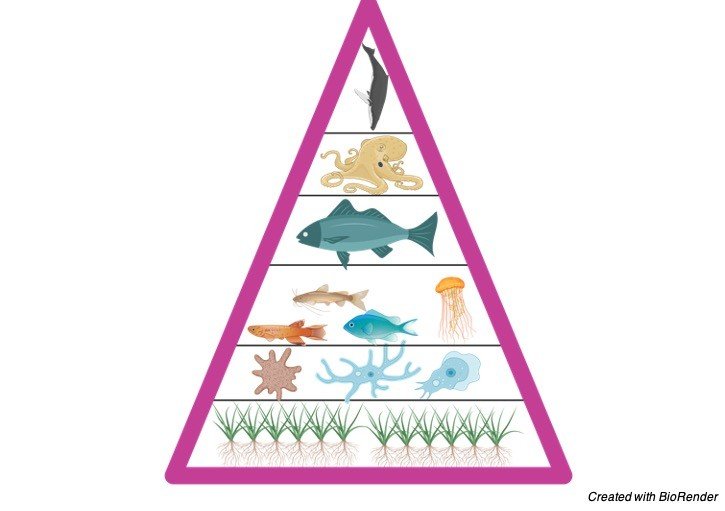
Third trophic level: first level predatory customers (auxiliary) consumes primary. Adolescent phases of fish and jellyfish, little fish, scavengers and ocean stars.
Fourth trophic level: second level meat eating customers (tertiary buyers) consumes auxiliary. Bigger fish.
Fifth trophic level: third level flesh eating purchasers (quaternary customers) consumes tertiary. Squid, octopus, bigger fish.
Sixth trophic level: top meat eating (quinary customers) consumes quaternary. Shark, dolphin, gooney bird.
How Ecological Productivity of Aquatic Environments Maintained?
Ecological productivity characterized as the exchange of energy between trophic levels or at the end of the day is the productivity with which energy moved starting with one trophic level then onto the next trophic levels.
There are two significant physical science laws in the investigation of energy course through the environment.
First thermodynamics law expresses that energy can’t be made or annihilated and it can just changed starting with one structure then onto the next.
Sun is the wellspring of energy that consumed by the essential makers where in it is changed over to put away substance energy for the working of an environment.
The second law of thermodynamics expresses that at whatever point energy is changed, there is a misfortune energy through the arrival of warmth and loss of energy additionally happens during breath and development.
Energy misfortune happens when energy is moved between trophic levels where more what’s more, more energy lost as one maneuver up through trophic levels when one creature takes care of off another creature.
In oceanic environments, phytoplankton complete the majority of the photosynthesis that happens.
The majority of phytoplankton essential creation is burn-through and utilized for energy on the grounds that phytoplankton are little creatures with straightforward designs.
Even though phytoplankton are little yet, they become quickly and they support huge populaces of herbivores.
This is the explanation why oceanic biological systems can uphold more trophic levels than the land environments.
Oceanic environments normally have higher productivity in contrast with land biological systems in light of the fact that higher extent of ectotherms and makers like the green growth needs ligin.
The primary makers with 1000 units energy moved 10% to 100 units energy for herbivorous. Constantly diminished of 10% energy to 10 units and 1 unit energy for first request carnivores and up to second request carnivores.
The entirety of the purchasers as it climbs from one trophic level to another trophic level varies in its healthful relationship with the maker.
Energy is left behind a food chain or web from lower to higher trophic levels changes from 5 to 20 percent, normal 10% of the energy at one level accessible to next trophic level.
The other 90% of energy utilized for metabolic cycles or emitted as warmth to the climate.
Trophic Level and Energy Balance
Each trophic level loses energy so it frequently showed as a triangle with essential makers framing the base.
The more trophic levels present, the less energy preserved at higher trophic levels.
Each trophic level backings fewer living beings as the consequence of just normal 10% of the energy from a life forms moved to its shopper.
For instance in the amphibian trophic level, a high level shopper like shark or fish is upheld by a huge number of essential makers, for example, phytoplankton from the foundation of trophic pyramid or the food web.
Estimation of energy move effectiveness between two progressive trophic levels is named as the trophic level exchange effectiveness (TLTE) and is characterized by the equation.
Trophic level Exchange Effectiveness
Trophic level exchange effectiveness is a proportion of how much energy happens at one level partitioned by the energy at the level underneath it times hundred.
Ecological effectiveness portrays proficiency with which energy moved starting with one trophic level then onto the next trophic levels and controlled by a blend of efficiencies identifying with organismic asset obtaining and osmosis in an environment.
Trophic productivity fuses with three sorts of effectiveness.
First is the extent of accessible energy that is burned-through known as utilization effectiveness.
Second, the extent of ingested food that is absorbed or absorption effectiveness.
Thirdly is the extent of acclimatized food that goes into new customer biomass known as creation productivity.
Ecological productivity is the exchange of energy between trophic levels or the energy streams inside a food web.
A lot of energy are lost starting with one trophic level then onto the next level as energy streams from essential makers to the different trophic levels of buyers and decomposers.
Level of energy moved shifts from 5 to 20 percent, normal 10% from one trophic level to higher levels and the rest misfortune as a warmth.
The main consideration that restricts the length in a food chain or food web is the low effectiveness of energy move between trophic levels.
There isn’t sufficient energy to help another trophic level after four up to six energy moves.
Sea-going biological systems can uphold more trophic levels contrast with the land environments due to higher productivity.
Trophic Level Citations
- Plant genotypic diversity effects on soil nematodes vary with trophic level. New Phytol. 2021 Jan;229(1):575-584.
- Environmental correlates of food-chain length, mean trophic level and trophic level variance in invaded riverine fish assemblages. Sci Total Environ . 2018 Dec 10;644:420-429.
- Trophic level and basal resource use of soil animals are hardly affected by local plant associations in abandoned arable land. Ecol Evol . 2020 Jul 7;10(15):8279-8288.
- Evidence for a multi-level trophic organization of the human gut microbiome. PLoS Comput Biol . 2019 Dec 19;15(12):e1007524.
Share
Similar Post:
-

Detritivore: Definition, Function, and Examples I Research...
Continue ReadingDetritivore Definition
A detritivore is a heterotrophic living being, which gets its nourishment by benefiting from waste.
Debris is the natural matter comprised of dead plant and creature material.
Detritivores may likewise acquire nourishment by coprophagy, which is a taking care of technique including the utilization of dung.
Detritivores are regularly invertebrate bugs like parasites, creepy crawlies, butterflies, and flies; mollusks like slugs and snails; or soil-abiding worms, millipedes and woodlice.
Detritivore Examples
Instances of detritivores in marine conditions are scavangers like crabs and lobsters, echinoderms, for example, ocean stars or ocean cucumbers.
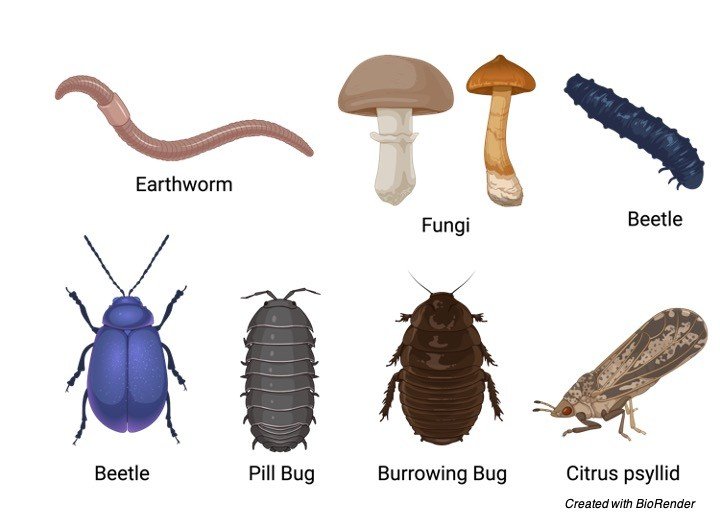
A considerable lot of these marine detritivores involve a comparative specialty to earthbound soil-tenants, living on or inside the seabed known as the benthos. These creatures are frequently called “bottom dwellers”.
Then again in amphibian biological systems, fixed polychaete worms, barnacles and a few corals determine their energy through channel benefiting from skimming natural rubbish called “marine snow”.
Detritivore or Decomposer
The expressions “detritivore” and “decomposer” are particular in their importance; albeit the words are frequently utilized conversely, detritivores are actually a part of decomposers.
It is valuable to take note of that, not at all like detritivores, genuine decomposers like organisms, microorganisms or protists, use saprotrophic taking care of, in which they assimilate supplements through extracellular processing, as opposed to by oral ingestion.
Likenesses can notwithstanding be drawn among detritivores and scroungers.
However while both of these taking care of systems include the utilization of dead plant and creature matter, foragers will in general benefit from a bigger scope than detritivores, practicing on remains and excrement.
Detritivore Features
Detritivores and decomposers add to the breakdown of the entirety of the dead and rotting material in any biological system.
In this manner they assume a significant part in the cycling of supplements and are a fundamental piece of most biogeochemical cycles, for example, the carbon cycle, nitrogen cycle and the phosphorus cycle.
Detritivores feed on material from essential makers just as herbivores and carnivores, and in this way are available all through all trophic levels in a biological system.
Just as burning-through energy from different life forms, they are generally eaten by optional buyers, thus they are a fundamental segment of the environment energy cycle.
Not exclusively is the reusing interaction a significant piece of decay, the evacuation of dead material is critical to stop the spread of illness.
Furthermore, detritivores that live inside the dirt, for example worms, circulate air through and stir up the dirt with their development, which is significant for the development of plants.
Importance of Detritivore: Worms
Worms are quite possibly the main soil-staying detritivores. They devour a lot of natural matter and soil and are available all through all layers of their substrate.
Epigeic worms live on a superficial level, while endogeic worms live in the upper layer of soil.
These two sorts of worm will in general benefit from dead grass, fallen leaves and other bioorganic materials like parasites, green growth and the microorganisms that are additionally benefiting from these substances.
Anecic worms live profound inside the dirt, fundamentally comprising off crude soil, albeit this contains numerous microorganisms, parasites and green growth.
Worms take in food through their mouths, and ‘suck’ it into the stomach related framework utilizing a strong activity. As the material goes through their stomach related framework into their ‘gizzard’, it is dependent upon stomach related compounds just as the pounding activity coming about because of the presence of coarseness and sand from the dirt.
A ‘cast’ is dropped of the backside of the worm. The cast is fundamentally a more handled form of the admission soil, with more modest supplement particles accessible for decay by different creatures.
The presence of the microorganisms inside the waste devoured by the worms additionally accelerates the disintegration interaction all through absorption. Due to their taking care of system, worms are continually moving.
This development assists with stirring up and circulate air through the dirt, which additionally further develops water take-up and transportation of supplements, permitting plants to develop all the more effectively.
Detritivore and Decomposition Cycle
Garbage is comprised of Particulate Organic Material (POM) that is shaped from tissues kept when plants and creatures kick the bucket or when they shed skin or prongs through shedding, just as fecal matter and microorganisms.
The provinces of microorganisms inside the garbage add to its healthy benefit.
In earthbound conditions, debris might be available as humus (the dead materials blended in with soils), or as leaf litter.
In sea-going conditions, the garbage is suspended as “marine snow”, which at last tumbles to the seabed. The entirety of this material contains energy, just as the supplements that were available in the waste material and the assortments of the perished.
These substances are important items in all energy and supplement cycles, albeit the minerals and mixtures should be made accessible by actual breakdown and biochemical change of the material through disintegration or remineralisation.
Detritivores feed on the bigger particulate material in the beginning phases of disintegration, and in doing as such, section the material in to more modest measured pieces.
The discontinuity cycle expands the surface region accessible, for assault by microscopic organisms and different microorganisms, and subsequently helps and paces up the decay interaction.
Absorption by the detritivores additionally separates a few sugars, proteins and lipids present in the garbage in to less difficult substances.
The water-dissolvable supplements delivered from this drain into the dirt and increment the dirt mineral substance.
Simultaneously, the detritivores are extricating nourishment for their own life cycles, and in doing as such, contribute their biomass to the natural way of life when they are eaten by buyers.
Constantly all through the interaction, decomposers like organisms and different microorganisms, otherwise called saprophytes, perform genuine disintegration, utilizing synthetic mixtures and stomach related catalysts to change over material discharged by the detritivores into additional less complex substances like inorganic carbon.
These cyclic substances are vital for all life, for instance, inorganic carbon delivered from breath of decomposers is taken in by plants and is utilized to perform photosynthesis.
Progressive deterioration of the altered natural matter outcomes in humification – the development of humus – a sort of soil with a high mineral substance and dependability.
Detritivore Citations
- Potential macro-detritivore range expansion into the subarctic stimulates litter decomposition: a new positive feedback mechanism to climate change? Oecologia . 2011 Dec;167(4):1163-75.
- Quantity and quality limit detritivore growth: mechanisms revealed by ecological stoichiometry and co-limitation theory. Ecology . 2017 Dec;98(12):2995-3002.
- Herbivore and detritivore effects on rainforest plant production are altered by disturbance. Ecol Evol . 2019 Jun 4;9(13):7652-7659.
- Detritivore conversion of litter into faeces accelerates organic matter turnover. Commun Biol . 2020 Nov 11;3(1):660.
Share
Similar Post:
-

Stem Cells: Types, Therapy, Uses, and Function
Continue ReadingWhat Are Stem Cells?
Stem cells are human cells that can form into a wide range of cell types. This can go from muscle cells to synapses. At times, they can likewise fix harmed tissues.
Scientists accept that stem cell-based treatment may one day be utilized to treat genuine ailments, for example, loss of motion and Alzheimer’s disease.
Stem cells are unspecialized cells that form into the specific cells that make up the various sorts of tissue in the human body. They are described by the capacity to recharge themselves through mitotic cell division and separating into an assorted reach of particular cell types.
They are indispensable to the turn of events, development, support, and fix of our minds, bones, muscles, nerves, blood, skin, and different organs.
Stem cells are found in every last one of us, from the beginning phases of human improvement to the furthest limit of life.
Stem cell research holds enormous guarantees for the advancement of novel treatments for some genuine illnesses and wounds.
While stem cell based medicines have been set up as a clinical norm of care for certain conditions.
For example; hematopoietic stem cell transfers for leukaemia and epithelial stem cell-based medicines for consumes and corneal issues, the extent of potential stem cell-based treatments has extended as of late because of advances in stem cell research.
It has been as of late that researchers have perceived stem cells well enough to think about the potential outcomes of developing them outside the body for significant stretches of time.
With that development, thorough examinations can be directed, and the chance of controlling these cells in such a way that particular tissues can be developed is genuine.
Type of Stem Cells
Stem cells are isolated into 2 principal structures. They are undeveloped stem cells and grown-up stem cells.
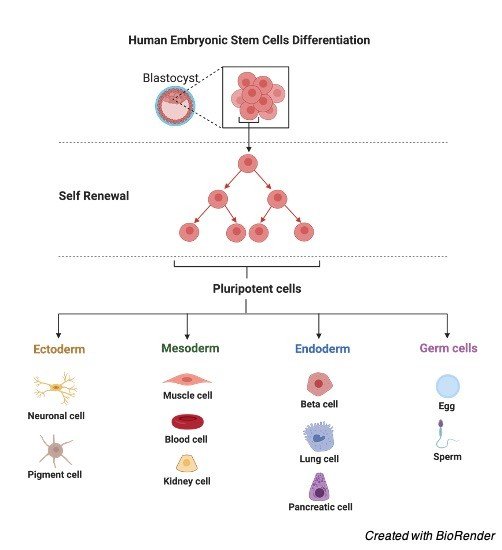
I. Embryonic Stem Cells
The Embryonic stem cells utilized in research today come from unused incipient organisms.
These outcome from an in vitro treatment system. They are given to science.
These early-stage stem cells are pluripotent.
This implies that they can transform into more than one kind of cell.
II. Adult Stem Cells
There are two sorts of adult stem cells. One sort comes from completely created tissues like the mind, skin, and bone marrow.
There are just little quantities of stem cells in these tissues.
They are bound to produce just particular sorts of cells.
For instance, a stem cell that comes from the liver will just make more liver cells.
The subsequent kind is initiated pluripotent stem cells. These are grown-up stem cells that have been changed in a lab to be more similar to early-stage stem cells.
Researchers originally revealed that human stem cells could be changed in this manner in 2006.
Instigated pluripotent stem cells don’t appear to be not the same as undeveloped stem cells, yet researchers have not yet discovered one that can foster each sort of cell and tissue.
Stem Cells in Medication
The stem cells presently used to treat sickness are hematopoietic stem cells. These are the platelet shaping grown-up stem cells found in bone marrow.
Each sort of platelet in the bone marrow begins as a stem cell.
Stem cells are youthful cells that can make other platelets that develop and capacity depending on the situation. These cells are utilized in methods, for example, bone marrow transfers.
These assistance individuals with disease make fresh blood cells after their own hematopoietic stem cells have been killed by radiation treatment and chemotherapy.
They may likewise be utilized to treat individuals with conditions like Fanconi sickliness. This is a blood problem that makes the body’s bone marrow fizzle.
Stem cells may help your wellbeing in the future from multiple points of view and through numerous new medicines. Specialists imagine that stem cells will be utilized to assist with making new tissue.
For instance, one day medical care suppliers might have the option to treat individuals with persistent coronary illness. They can do this by developing sound heart muscle cells in a lab and relocating them into harmed hearts.
Different medicines could target sicknesses, for example, type 1 diabetes, spinal rope wounds, Alzheimer infection, and rheumatoid joint inflammation.
New medications could likewise be tried on cells produced using pluripotent stem cells.
Potential Stem Cells Therapy
Various stem cell therapeutics exist, yet most are at trial stages or potentially expensive, with the exceptional case of bone marrow transplantation.
Clinical analysts expect that grown-up and early-stage stem cells can soon treat cancer, Type 1 diabetes mellitus, Parkinson’s sickness, Huntington’s infection, Celiac Disease, cardiovascular disappointment, muscle harm and neurological problems, and numerous others.
They have proposed that before stem cell therapeutics can be applied in the clinical setting, more exploration is important to comprehend stem cell conduct upon transplantation just as the systems of stem cell association with the ailing/harmed microenvironment.
Bone marrow transfers (BMT) are a notable clinical utilization of stem cell transplantation.
BMT can repopulate the marrow and reestablish all the distinctive cell kinds of the blood after high dosages of chemotherapy and additionally radiotherapy, our primary guard used to kill endogenous cancer cells.
Stem Cells Therapy in Diabetes
Diabetes influences a huge number of individuals in the world and is brought about by the unusual digestion of insulin.
Ordinarily, insulin is created and emitted by the cellular structures called the islets of Langerhans in the pancreas. As of late, insulin communicating cells from mouse stem cells have been created.
What’s more, the cells self-gather to frame structures, which intently look like ordinary pancreatic islets and produce insulin.
Future examination should explore how to upgrade conditions for insulin creation determined to give a stem cell-based treatment to get diabetes swap the consistent requirement for insulin infusions.
Why Stem Cell Research is Difficult?
Stem cells need substantially more examination before their utilization can be extended.
Researchers should initially study how to create early-stage stem cells. This will assist them with seeing how to control the sort of cells made from them.
Another test is that the early-stage stem cells accessible today are probably going to be dismissed by the body.
What’s more, a few groups discover it ethically disturbing to utilize stem cells that come from undeveloped organisms.
Researchers additionally face difficulties when utilizing grown-up pluripotent stem cells.
These cells are difficult to fill in a lab, so scientists are investigating approaches to work on the interaction.
These cells are likewise found in modest quantities in the body.
Stem Cells Citations
- Such Various Stem Cells. Biochemistry (Mosc) . 2019 Mar;84(3):187-189.
- Towards a classification of stem cells. Elife . 2019 Mar 13;8:e46563.
- Stem/progenitor cells in liver development, homeostasis, regeneration, and reprogramming. Cell Stem Cell . 2014 May 1;14(5):561-74.
- Stem cells: their source, potency and use in regenerative therapies with focus on adipose-derived stem cells – a review. Biotechnol Adv . Jul-Aug 2018;36(4):1111-1126.
- Wnt signalling in stem cells and cancer. Nature . 2005 Apr 14;434(7035):843-50.
- DNA Damage in Stem Cells. Mol Cell . 2017 May 4;66(3):306-319.
- Introduction to stem cells and regenerative medicine. Respiration . 2013;85(1):3-10.
Share
Similar Post:








